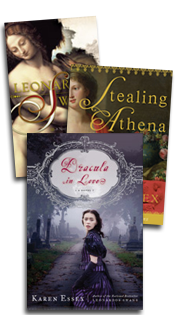1. It’s been 2000 years since Kleopatra reigned. I’ve always said that if you think Madonna is impressive, you really have to learn more about Kleopatra. Why is it that there are no women of today with Kleopatra’s great power? Though we are now in post-feminist times, what women of today, if any, have anywhere near her power and influence? What has changed in 2000 years, and what has not?
2. The Romans designed and perpetrated an image of Kleopatra as a sexually wanton overly-ambitious woman. Do we still see women being sexualized in order to be discredited? In order to have their power stripped from them? Do we still see examples that ambition in a woman is a crime, whereas in a man, it is a virtue?
3. Compare and contrast Kleopatra with other great queens, Elizabeth I and Queen Victoria? Do you see parallels in their quests for unity, empire and war, and inter-family rivalry and succession issues. How do royal families of today compare?
4. Kleopatra used her appearance and style to assert her authority and to speak to her people in symbolic language. Do you see similarities to today’s women such as Madonna or Britney Spears?
5. In Kleopatra’s day, the link between religion and government was indelible. Compare the link between religion and government then and now, and how that battle is still being played out in different countries.
6. In Kleopatra, I really wanted to tell her story outside the context of Julius Caesar and Mark Antony. Too many women’s stories are told through the stories of the men with whom they were involved. Why is this so, and how would our perception of women be changed if women’s stories were told from women’s points of view.
7. I have always thought of the real Kleopatra as a great role model of power for women. Does Kleopatra resonate for you in this way?
8. How does this portrait of Kleopatra differ from your impression of her before you read the book?
9. How important was it that she was the first of her dynasty to speak the language of the people? What does this say about her? Imagine if our leaders did not speak English, but communicated to us through interpreters. If only a tiny educated elite spoke the same language as our government officials?
10. How does the portrait of the eunuchs differ from your impression of eunuchs before you read the book? What do you think of Meleager’s defense of his “kind” as noble and loyal?
11. How do you view the sexual customs of the ancient world as opposed to contemporary sexual customs? How do you feel about the bisexual practices imbedded into ancient culture, or about sexual coupling as part of religious worship? These practices were quite serious and not practiced for frivolity. Why did these things become taboo?
12. The idea of warrior women and warrior queens is not myth but reality, and I wanted to reflect that in the book. Recent archeological excavations have produced graves of women from this period who were buried with their weapons. Ancient sources say that Kleopatra was “free of all womanly fear;” that she hunted and fished and rode horses with Antony. Berenike really did seize the throne, raising an army against her father before she was eighteen years old. Mohama, on the other hand, is an invented character, based on the assumption of some scholars that Kleopatra was the African princess who erected a funerary monument to her female companion in Athens. How do the portraits of women like Mohama and Berenike differ from your idea of women of the ancient world?

Book Excerpt | Reader’s Guide |Classroom Guide | Letters From Students | Bibliography | Inspiration


